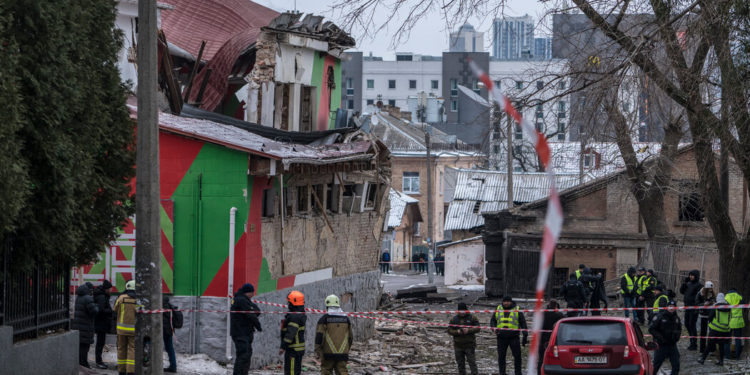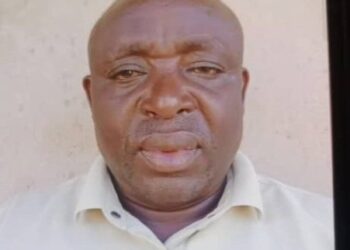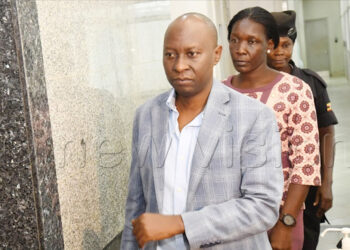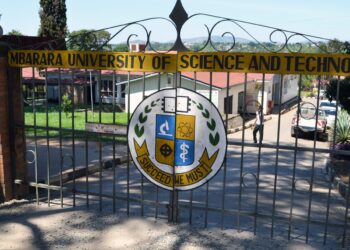By THE NEW YORK TIMES
Russia launched a combination of cruise and ballistic missiles at Ukrainian cities on Tuesday in a large volley that killed at least five people and wounded another 63, including children, according to local and military authorities. The assault added to concerns about the state of Ukraine’s air defenses as Russian barrages continue on its largest cities.
Ukraine’s air force said that 41 missiles had entered the country’s airspace early Tuesday. The Ukrainian authorities provide details of cruise missiles in flight, and residents can track them for about an hour as they fly from Russia. The ballistic missiles, which travel much faster, struck in Kyiv on Tuesday just as the cruise missiles arrived.
Yuriy Ihnat, an air force spokesman, said in a telephone interview that the military had intercepted only about half of the total barrage, and just five of the 24 ballistic missiles. That was a lower success rate for Ukraine than achieved against earlier bombardments, because ballistic missiles, which are harder to intercept, made up a higher proportion of Tuesday’s volley, he said.
“Most of missiles were ballistic, and our air force can’t down them all,” Mr. Ihnat said.
In Kyiv, the capital, at least one missile appeared to detonate at ground level, residents said, although it was unclear whether it had evaded Ukraine’s air defenses or whether the warhead fell and blew up after the missile was destroyed in the air.
Concern has grown in Ukraine that air defense ammunition will run low as further military aid from the United States remains stalled in Congress. Mr. Ihnat said that the air force had not run out of ammunition in Tuesday’s assault, but that Ukraine did require a regular resupply.
He also said that not all of the missiles that evaded Ukraine’s defenses had hit their targets. “Many of them just fell in the fields, as Russian missiles’ quality has decreased,” he said.
Residents of the capital awoke to an air-raid alarm around 6 a.m., followed by explosions and the rattle of machine guns firing at the cruise missiles. Missiles or falling debris struck five neighborhoods in Kyiv, according to the city’s mayor, Vitali Klitschko. The police strung red tape around strike sites, and emergency workers cleared bricks and broken glass from the streets.
One explosion from either falling debris or a missile rang out in the government district in central Kyiv, near the presidential office and Parliament. It was the first damage from a missile attack in the district since October 2022.
In the city’s Sviatoshynsky district, an older man stood on the street, shaking and crying, after watching wounded children being evacuated from one strike site. “Their entire bodies were bandaged,” said the man, who declined to give his name. He struggled to say anything more.
Cars caught fire on a street in one district. Mr. Klitschko wrote on the Telegram social messaging app that a warhead from one intercepted missile had landed in a resident’s kitchen but did not explode.
In Kharkiv, Ukraine’s second largest city, missiles killed two people and wounded at least 38, the mayor, Ihor Terekhov, wrote on Telegram.
Missiles hit at least four locations in the city, whose center is just 25 miles from the Russian border — the first strikes around 4 a.m. and another salvo three hours later, the head of the regional military administration, Oleh Syniehubov, said in a brief interview at the site of one of the strikes.
Tetiana Derevianko, who lives in the city, said she had been asleep in her ninth-floor apartment when a powerful blast jolted her awake. Her husband, Stas, was in the kitchen and was thrown against the refrigerator, an impact that split his forehead open.
As blood streamed down his face, he called out to his wife.
“Stas shouted to get up to hide behind the second wall,” she said. “We lay on the floor and prayed.”
In those chaotic first moments, she thought their building had been hit. But they had been spared the worst: The missile struck a five-story apartment building next door, reducing it to a heap of twisted metal and concrete.
Ukraine’s military said its soldiers had shot down one cruise missile with a machine gun, a rare feat that could not be independently confirmed. Typically, fighter jets or ground-based antiaircraft missiles are needed to intercept cruise missiles.
As Russia pressed ahead with its assaults on Ukraine, NATO officials in Brussels announced on Tuesday that the military alliance had signed contracts worth $1.2 billion to buy 155-millimeter caliber artillery shells — one of the most-needed weapons on Ukraine’s battlefields.
The estimated 220,000 shells will not be delivered for at least two years, officials said, and will be sent to member states to refill stockpiles that have been depleted by military assistance to Ukraine. It will be up to NATO states to decide whether they can spare more for Kyiv.
“Russia’s war in Ukraine has become a battle for ammunition,” said Jens Stoltenberg, the NATO secretary general.
Officials did not say which ammunition producers — whether based in Europe, the United States or elsewhere — would manufacture the shells.
Across Ukraine on Tuesday morning, thousands of people took shelter with their children in basements or subway stations. After the explosions in Kyiv, some rushed out to check on their homes and businesses.
“We ran to try to save anything we could from our shop,” said Ina Halushko, 50, the owner of a grocery store about a hundred yards from one of the sites hit in Kyiv. Its windows were shattered, she said as she pointed toward the store, but the building did not catch fire.
In Kyiv, people who had gathered near a building that was damaged by falling missile debris said they worried about the diminishing supply of antiaircraft missiles protecting the city.
“If America stops supporting us, next time you won’t see me here,” said Olesya Dubinska, who lives in a nearby building. She was watching emergency crews clean up the site with her dog, a black Doberman named Lucky.
“We understand the forces are not equal,” she said. “Our territory is far smaller than Russia. Of course we need help.”
Andrew E. Kramer contributed reporting from Kyiv, Ukraine, Marc Santora and Liubov Sholudko from Kharkiv, and Lara Jakes from Rome.







Discussion about this post